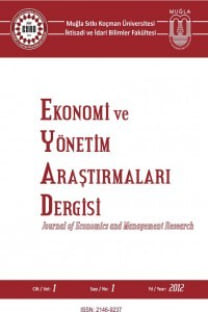YOKSULLUKLA MÜCADELEDE SOSYAL KORUMA HARCAMALARI: AVRUPA BİRLİĞİ ÜLKELERİ ÜZERİNE BİR İNCELEME
ÖZETAvrupa Birliği ülkelerinde sosyal koruma harcamalarının yoksulluğun azaltılması üzerindeki etkisinin araştırıldığı bu çalışmada yoksulluk oranları toplam yoksulluk, kadın yoksulluğu, 65 ve üzeri yaştaki bireylerde yoksulluk ve işsiz bireylerde yoksulluk özelinde ele alınmıştır. Çalışma sonuçları bir bütün olarak değerlendirildiğinde sosyal koruma harcamalarının GSYH içindeki payı arttıkça yoksulluk oranlarının ters yönde etkilendiği bulgusuna ulaşılmıştır. Bu ters yönlü ilişki, 65 ve üstü yaştaki bireyler ile işsiz bireylerdeki yoksulluk oranlarında daha güçlüdür. Bununla birlikte Almanya, Slovenya, Danimarka, İngiltere ve İtalya’nın göreli olarak daha fazla sosyal koruma harcaması yapmış olmalarına rağmen 65 ve üstü yaştaki bireyler ile işsiz bireylerdeki yoksulluk oranlarını düşürmede başarısız oldukları görülmektedir. Elde edilen bu sonuç, bu ülkelerde izlenen sosyo-ekonomik politikaların ve gerçekleşen sosyal fonksiyonlarının amaçlarına tam olarak hizmet etmediğini göstermektedir.Anahtar Kelimeler: Yoksulluk, Sosyal Koruma Harcamaları, Yoksullukla Mücadele, Avrupa BirliğiJel Kodları: I38, E62,H20,H24
Anahtar Kelimeler:
Yoksulluk, Sosyal Koruma Harcamaları, Yoksullukla Mücadele
SOCIAL PROTECTION EXPENDITURES IN STRUGGLE WITH POVERTY: A STUDY ON THE EUROPEAN UNION COUNTRIES
This study examines the effect of the social protection expenditures in the European Union countries on the reduction of poverty and it deals with the total poverty, female poverty, poverty of individuals who are 65 and older, and poverty of unemployed individuals. When we evaluated the results of the study as a whole, we found that the poverty ratios were inversely affected as the ratio of the social protection expenditures to the gross domestic product GDP increased. This inverse relation is stronger among individuals who are 65 and older and among unemployed individuals. On the other hand, Germany, Slovenia, Denmark, England and Italy were found to be unsuccessful to reduce the poverty ratios among individuals who are 65 and older and among unemployed individuals although they had relatively more social protection expenditures. This result indicates that the socio-economic policies followed in these countries and the actual social functions do not fully serve their purposes
___
- Atkinson, A. (2000). A European Social Agenda: Poverty Benchmarking and Social Transfers. Euromod Working Paper Series, No: EM3/00, Jully.
- Atkinson, T. Cantillon, B. Marlier, E. Nolan, B. (2002). Social Indicators: The EU and Social Inclusion. Oxford: Oxford University Press. First Edition.
- Balcı, Ş. G. (2007). Tutunamayanlar ve Hukuk. Ankara: Dost Yayınevi.
- Beblo, M. Knaus, T. (2001). Measurement Income Inequality In Euroland. The Rewiew of Income and Wealth. 47 (3), 301-320.
- Behrendt, C. (2000). Holes In The Safety Net? Social Security and The Alleviation of Poverty In a Comparative Perspective, Social Security In The Global Village, The Year 2000 International Research Conferance on Social Security. 25- 27 September. Helsinki.
- Brady, D. (2005). The Welfare State and Relative Poverty In Rich Western Democracies. Social Forces, 83 (4), 1329-1364.
- Buğra, A. (2009). Kapitalizm, Yoksulluk ve Türkiye’de Sosyal Politika. İstanbul
- ISSN: 2146-9237
- Başlangıç: 2012
- Yayıncı: Mugla Sitki Kocman University
Sayıdaki Diğer Makaleler
YOKSULLUKLA MÜCADELEDE SOSYAL KORUMA HARCAMALARI: AVRUPA BİRLİĞİ ÜLKELERİ ÜZERİNE BİR İNCELEME
İbrahim GİRİTLİOĞLU, Halil İbrahim KARAKAN, Bilal Nadir ALKAN, Harun Reşit GÜNDOĞAN
SOSYAL DEVLET ANLAYIŞININ YEREL KARŞILIĞI: SOSYAL BELEDİYECİLİK VE TEMEL SORUNLARI
Aysun YILMAZTÜRK, Tahsin GÜLER
DAĞITILMAYAN YABANCI KARLARIN BELIRLEYICILERI
SON DÜZENLEMELER IŞIĞINDA İHRACATTA KDV’NİN İADESİ VE MUHASEBELEŞTİRİLMESİ
